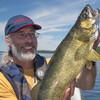
Connected by canoeing

During a kilometre-long portage into a small brook trout lake in Lake Superior Provincial Park, my 19-year-old daughter, Lillian, stoops to pick fiddleheads along a damp and mossy stream bed. I continue, canoe on my shoulders, toward the waters that appear through a break in the thick and shapely shoreline cedars.
I don’t often get time alone with my daughter. Although it is a priority, it’s one that is often thwarted by the great whirlwind of work and responsibilities that blows through our lives. But today, as I tread carefully down a slight incline towards the lake, the storms of life have abated; Lillian has a few days off from her new fire fighting job in northern Ontario and we manage to grab our dog, Simpkin, and steal away for a little father-daughter overnight adventure.
Part of Lillian’s firefighting training is carrying heavy loads for extended periods of time, and this works out quite well for a father who is used to doing the bulk of the carrying over the portage trail. By the time I slide the canoe off my shoulders and set it down on the collection of boulders and beaver-chewed wood at the side of the lake, Lillian is arriving with the heaviest pack and a few handfuls of fiddleheads.

We load the canoe and paddle along a steep shoreline, where angular boulders and waterlogged wood disappear into the depths of tea stained water. Above the waterline cedars, birch, and maple cower below tall white pine, permanently bent against the prevailing winds. We brought food for supper, but as we troll lures up to what looks like a great campsite, I catch a 16-inch brook trout.

Typical of her species, she is gorgeous, with dark hide, ivory-tipped fins and dappled with yellow and red spots within bluish halos.

My inclination is to let the bespeckled creature go but, after a quick discussion, Lillian and I embrace the idea of nourishing ourselves from the land, and the trout is earmarked for dinner.
The campsite is even better than expected. Waterfront promontories of rounded granite surrender to a cedar grove, where a fire pit and tent site are sequestered under arcing branches. While Simpkin works the perimeter with her nose to the ground, Lillian pitches the old Eureka on a bed of soft, golden pine needles.

Sitting on a warm flat rock that slopes into the water, I carefully cut two fillets of brilliant red flesh from the trout and season them with salt and pepper. Lillian has the flames dancing beneath a hot frying pan and I slide the fillets in, skin side down. They take on a deep pinkish hue as they cook. I flip the frying flesh then add fiddleheads to the flame-licked pan, along with a dollop of butter, more salt and pepper, and a drizzle of lemon juice.

With our canoe overturned on the point and a tired dog curled up under a spruce, father and daughter sit around the fire, plates on our laps.

Within the pine-charged air, amidst wafts of wood smoke, we savour every mouthful and every minute. There is a level of satisfaction that goes well beyond the satiation of hunger. Although it’s not spoken, Lillian and I both know that we’ve arrived at a place we can only get to by canoe.

MUST WATCH – THE CONNECTOR
Michell Savoie shares her family story of how canoeing teaches core values, skills and love of nature, and is best shared with your most loved ones.
Recommended Articles

Crown Land Camping

Natural Highs

Dog Sledding in Ontario

11 Jaw-Droppingly Beautiful Landscapes

Backpacking Trails in Ontario

Dogs Welcome!

2025 Triathalons

Best Cross Country Ski Spots

Want to go snowshoeing?

Plan Your Adventure

Best Winter Getaways in Ontario

6 Best Places To Camp On Manitoulin

Ontario Birding Checklist
Girls’ Getaways

Your Family’s Best Summer Ever

Top Summer Vacations In Northern Ontario

Call Us Crazy

Attention Detroit
9 of the Most Beautiful Fall Destinations



